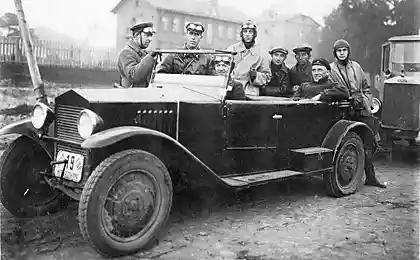466
Mechanisms of influence —WHAT moves us
It's amazing how often we do things that are hardly amenable to logic or reasonable explanation. Acting “on automatic”, we do not think that motivates us and encourages us to do so, and not otherwise. Everything happens faster than we have time to understand (as he wrote Cialdini, punk sagwala).
The authors of the book “Age of propaganda: Mechanisms of persuasion” by E. Aronson and E. R. Pratkanis present results of interesting studies and experiments, revealing different mechanisms of influence. Here are some of them.

1. Any reason will do.
Ellen Langer and her colleagues conducted the following experiment aimed at assessing deliberation of decisions.
Employees of Langer approached people using a University copy machine and said, “Excuse me, can I use the photocopier?”. Only slightly more than half the people agreed to fulfill this request.
But Langer found that could get almost everyone to agree to skip another person to the copy machine, adding to the request of one detail – the reason why the copier was needed. That makes sense.
Just need to be heartless to not give someone, probably panicked because of urgent need, just to use the copy machine.
Unusually in the study of Langer that although some of the above reasons do not make sense, almost all people missed asking ahead of him.
For example, in some cases, the staff Langer said, “Excuse me, may I use the Xerox, because I have to make copies?”.
With some reflection it just looks stupid: why else would you need a copier, not in order to make copies?
It's the same thing that he did not allow no reason. But the bottom line is this.
We especially easy to influence, when we think. For example, most of us from time to time subjected to harassment by beggars. A common reaction is to ignore the request and continue to walk down the street.
We recently encountered a new style of begging. A beggar approached us: “Excuse me, do you have for me 17 cents?”. What thoughts would come to mind in such a situation?
When it happened to us, my first thought was: “Why this man needs to be exactly 17 cents? To pay the fare on the bus? To purchase a particular food?”
Suddenly, the beggar was a real person with real needs, not someone that can be circumvented. We were convinced to part with a handful of change.
Intrigued, we later sent the students to beg on the streets donations for a local charity. They found that, compared to those situations when asked for a quarter or spare change that people gave donations almost 60% more when they asked for 17 cents or 37.
2. The power of labels
People tend to act in accordance with titles and labels that describe the event or situation. But the ability of words and labels to influence how we perceive and imagine the world extends to other contexts.
Many experiments have shown that if students are selected at random, mark as “a more capable, savvy”, they will tend to act as more sensible and clever; and women who put the label “beautiful” behave as if they really beautiful.
The study, Richard Miller, Philip Brickman, and Diana Bolin, illustrates the convincing power of the label in the atmosphere of the institution.
In one study of mechanisms of effects, Miller and his colleagues tried to convince pupils of the fifth class from Chicago to be careful and not make a mess – a task that most parents recognize a very difficult.
Part of the students lectured about how important it is to be neat and tidy, and in addition, lectures on ecology and the dangers of environmental pollution.
Other students lectures are not read, but said that they are neat and clean. The janitor said that their class is one of the cleanest in the school, but the teacher is encouraged to ponder why they're so neat.
What the results said? Students who have lectures, did not improve his behavior and continued to make a mess. A randomly selected fifth graders who were called “tidy” became neater and throwing garbage in the boxes 3 times more often than their peers.
The name of the created thing: a weed by any other name, it turns out, can be a rose.
3. How expectations create our reality
A study conducted by mark Snyder, Ellen Decker Tank, and Ellen Bershad, shows how our labels and conceptions of reality can actually change this reality.
Put yourself in the place of the typical male in their experiment: you have volunteered to participate in the study of “how people learn”, and you included a couple with a woman in another room, ostensibly because both of you according to the conditions of this study did not rely “no nonverbal communication”.
You will communicate with her on the phone. Although you have not seen your partner, you have provided about her some information, including a photograph. For half the subjects it was the very attractive women; others were given a relatively unattractive photo of a person.
What mechanisms of influence started in the minds of men the label of “attractive woman”? Men who thought they were talking with an attractive partner, valued her as more staid and prone to humor than those who thought that talking with a less attractive woman.
It's not so surprising. But the really amazing thing was this: when independent observers were given for you to listen to only the female half of the conversation (showing the photo), they are much more impressed with the woman whose partner thought she was physically attractive. Why?
Because partner thought she was talking to an attractive woman, he spoke to her in such a way that revealed all her best qualities. When independent observers listened to the conversation, they rated her as more attractive than the woman whose partner thought she was less beautiful.
4. The power of leading questions
Elizabeth Loftus conducted a series of experiments to find out how leading questions can influence eyewitness testimony. In one study, Loftus showed subjects a film depicting a car accident involving many cars.
After the film, some subjects were asked: “approximately what speed were the cars when they hit each other?”.
The rest of the subjects was asked the same question, but the word “crashed” was replaced by the word “hit”. Those who asked about the crashed cars, as opposed to hitting, thought that the cars were going much faster.
A week after watching the movie were more likely to say that in the scene of the accident was attended by the broken glass (although in the film showed no broken glass).
Leading questions has had a major impact not only on the evaluation of the facts and on the true memories of what happened.published
P. S. And remember, only by changing their consumption — together we change the world! ©
Join us in Facebook , Vkontakte, Odnoklassniki
Source: vk.com/true.journal?w=wall-41226912_71750
The authors of the book “Age of propaganda: Mechanisms of persuasion” by E. Aronson and E. R. Pratkanis present results of interesting studies and experiments, revealing different mechanisms of influence. Here are some of them.

1. Any reason will do.
Ellen Langer and her colleagues conducted the following experiment aimed at assessing deliberation of decisions.
Employees of Langer approached people using a University copy machine and said, “Excuse me, can I use the photocopier?”. Only slightly more than half the people agreed to fulfill this request.
But Langer found that could get almost everyone to agree to skip another person to the copy machine, adding to the request of one detail – the reason why the copier was needed. That makes sense.
Just need to be heartless to not give someone, probably panicked because of urgent need, just to use the copy machine.
Unusually in the study of Langer that although some of the above reasons do not make sense, almost all people missed asking ahead of him.
For example, in some cases, the staff Langer said, “Excuse me, may I use the Xerox, because I have to make copies?”.
With some reflection it just looks stupid: why else would you need a copier, not in order to make copies?
It's the same thing that he did not allow no reason. But the bottom line is this.
We especially easy to influence, when we think. For example, most of us from time to time subjected to harassment by beggars. A common reaction is to ignore the request and continue to walk down the street.
We recently encountered a new style of begging. A beggar approached us: “Excuse me, do you have for me 17 cents?”. What thoughts would come to mind in such a situation?
When it happened to us, my first thought was: “Why this man needs to be exactly 17 cents? To pay the fare on the bus? To purchase a particular food?”
Suddenly, the beggar was a real person with real needs, not someone that can be circumvented. We were convinced to part with a handful of change.
Intrigued, we later sent the students to beg on the streets donations for a local charity. They found that, compared to those situations when asked for a quarter or spare change that people gave donations almost 60% more when they asked for 17 cents or 37.
2. The power of labels
People tend to act in accordance with titles and labels that describe the event or situation. But the ability of words and labels to influence how we perceive and imagine the world extends to other contexts.
Many experiments have shown that if students are selected at random, mark as “a more capable, savvy”, they will tend to act as more sensible and clever; and women who put the label “beautiful” behave as if they really beautiful.
The study, Richard Miller, Philip Brickman, and Diana Bolin, illustrates the convincing power of the label in the atmosphere of the institution.
In one study of mechanisms of effects, Miller and his colleagues tried to convince pupils of the fifth class from Chicago to be careful and not make a mess – a task that most parents recognize a very difficult.
Part of the students lectured about how important it is to be neat and tidy, and in addition, lectures on ecology and the dangers of environmental pollution.
Other students lectures are not read, but said that they are neat and clean. The janitor said that their class is one of the cleanest in the school, but the teacher is encouraged to ponder why they're so neat.
What the results said? Students who have lectures, did not improve his behavior and continued to make a mess. A randomly selected fifth graders who were called “tidy” became neater and throwing garbage in the boxes 3 times more often than their peers.
The name of the created thing: a weed by any other name, it turns out, can be a rose.
3. How expectations create our reality
A study conducted by mark Snyder, Ellen Decker Tank, and Ellen Bershad, shows how our labels and conceptions of reality can actually change this reality.
Put yourself in the place of the typical male in their experiment: you have volunteered to participate in the study of “how people learn”, and you included a couple with a woman in another room, ostensibly because both of you according to the conditions of this study did not rely “no nonverbal communication”.
You will communicate with her on the phone. Although you have not seen your partner, you have provided about her some information, including a photograph. For half the subjects it was the very attractive women; others were given a relatively unattractive photo of a person.
What mechanisms of influence started in the minds of men the label of “attractive woman”? Men who thought they were talking with an attractive partner, valued her as more staid and prone to humor than those who thought that talking with a less attractive woman.
It's not so surprising. But the really amazing thing was this: when independent observers were given for you to listen to only the female half of the conversation (showing the photo), they are much more impressed with the woman whose partner thought she was physically attractive. Why?
Because partner thought she was talking to an attractive woman, he spoke to her in such a way that revealed all her best qualities. When independent observers listened to the conversation, they rated her as more attractive than the woman whose partner thought she was less beautiful.
4. The power of leading questions
Elizabeth Loftus conducted a series of experiments to find out how leading questions can influence eyewitness testimony. In one study, Loftus showed subjects a film depicting a car accident involving many cars.
After the film, some subjects were asked: “approximately what speed were the cars when they hit each other?”.
The rest of the subjects was asked the same question, but the word “crashed” was replaced by the word “hit”. Those who asked about the crashed cars, as opposed to hitting, thought that the cars were going much faster.
A week after watching the movie were more likely to say that in the scene of the accident was attended by the broken glass (although in the film showed no broken glass).
Leading questions has had a major impact not only on the evaluation of the facts and on the true memories of what happened.published
P. S. And remember, only by changing their consumption — together we change the world! ©
Join us in Facebook , Vkontakte, Odnoklassniki
Source: vk.com/true.journal?w=wall-41226912_71750
All of the Soviet filmstrips digitized and put into the Network until the end of 2016
Where to put unnecessary things in Moscow























